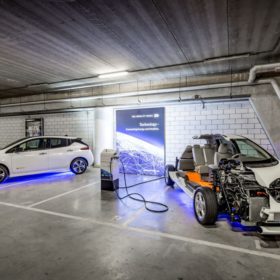Nissan Brazil and Federal University of Santa Catarina to cooperate on second-life EV battery research
As the global EV market grows, manufacturers are seeking new revenue streams for used EV batteries. Applications in grid and residential storage systems have become popular. The market for second-life EV batteries is expected to reach $4.2 billion by 2025.
1.4 GW NordLink interconnector receives €100 million EIB hybrid securities purchase
The project connecting Germany and Norway was first conceived in 2015. The 624 km undersea cable will have a capacity of 1.4 GW, when operational in 2020. The EU is supporting the project and other grid infrastructure projects through its EFSI scheme to interconnect the European energy markets, for better renewable energy integration and improved security of supply.
How EVs will transform our grids, or the death of the combustion engine
The driving force behind the innovative energy storage system installed at Amsterdam’s John Cruiff ArenA in the Netherlands, The Mobility House (TMH), talks to pv magazine about the death of the combustion engine, and how electric vehicles (EVs) are presenting both strong business cases, and unparalleled levels of flexibility via decentralized intelligence – blockchain technology – for electricity grids around the world.
Renewables body hails introduction of solar to UK capacity market
Solar – and wind – will finally bring an element of environmental consciousness, and value for money, to the system charged with keeping the lights on in Britain. Is PV finally shaking off long-held fears about its intermittent nature?
Odyssey surpasses $500 million mini-grid pipeline
Odyssey connects stakeholders along the mini-grid value chain to streamline development and financing processes. Reportedly over 275,000 connections would be achieved if the full pipeline is realized, and recently, it experienced a significant boost in a very dynamic mini-grid market.
Second-life EV battery market to grow to $4.2 billion by 2025
Circular Energy Storage, a London-based research and consulting group, reports a strong business case for reconstituted electric vehicle batteries for energy storage applications. As the EV and static storage system markets grow rapidly, synergies could be a useful tool for continued cost optimization.
EV charging infrastructure market to reach $18 billion by 2030
EV charging infrastructure is set to become a major market, and actors from different sectors like municipal utilities, inverter companies and storage system providers are getting creative, and collaborative, in order to secure a slice of the cake.
India solar water pump scheme could add 150 GW, report says
Greenpeace India, Germi, and the IWMI-Tata Water Policy Program have released a report stating that the Indian government’s latest ambitions to deploy solar water pumps could meet the country’s solar PV target of 100 GW, if done comprehensively. So far the plan goes as far as 28 GW, and still needs legislative approval.
Chinese shadow over latest IEA world energy report
The International Energy Agency’s latest study of global energy investment paints another rosy picture for solar – even as the authors warn of missed sustainable growth targets – but the report covers last year, and notes China’s policy about-turn could blow a cold wind through PV.
EU commits €578 million for Iberian-EU energy market integration
Spain, Portugal, France and the European Commission have signed a deal to increase the capacity of the energy interconnection between the Iberian Peninsula and Europe. Currently, the interconnection capacity is 6,000 MW and, thus, far from the 15% goal set in 2015.










